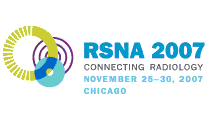
Abstract Archives of the RSNA, 2007
SST04-03
Usefulness of Contrast-enhanced Sonography (CEUS) in Cases of Small Size Renal Masses after Indeterminate CT or MRI Examination
Scientific Papers
Presented on November 30, 2007
Presented as part of SST04: Genitourinary (Ultrasound)
Catherine Roy MD, Presenter: Nothing to Disclose
Laurent Gengler, Abstract Co-Author: Nothing to Disclose
Benoit Sauer MD, Abstract Co-Author: Nothing to Disclose
Jeanne Flesch, Abstract Co-Author: Nothing to Disclose
Herve Lang, Abstract Co-Author: Nothing to Disclose
Christian Saussine MD, Abstract Co-Author: Nothing to Disclose
To assess the performance of Contrast Enhanced Sonography (CEUS) to characterize small renal masses after indeterminate CT or MR.
41 renal masses (mean diameter 1.3 cm, range : 0.8 - 2.0 cm) were studied with CEUS. All had previously underwent CT (14), MRI (13) or both (14) with indeterminate results. CEUS examinations were scanning with dedicated software (Elegra, Siemens) during two IV bolus of 2.5 ml of Sonovue R (Bracco, Italy) with cineloops recorded. Examinations with Doppler lasted 5 min after injection. Two readers reviewed dynamic data with knowledge of CT or MR. Sonographic criteria were subjectively evaluated as changes in the echogenicity and enhancement patterns after contrast injection. Benign lesions were diagnosed when there was no enhancement or a thin continuous peripheral enhanced rim with or without thin enhanced inner septas. Suspected malignant lesions were diagnosed as a peripheral enhancing nodular pattern or thick irregular septas or diffuse homogeneous or heterogeneous inner enhancement. Final diagnosis (28 surgery, 13 follow-up) were clear cell carcinoma (9), cystic renal cell carcinoma (14), multilocular cyst (6), simple (3) or benign cysts with thin septas (7) or hemorrhage (3).
Thick septas or nodules were found in 16 cases (2 false positive due to benign multilocular cyst). All clear cell carcinoma had diffuse heterogeneous (8) or homogeneous (1) enhancement. Two false positive were due to moderate homogeneous enhancement inside hemorrhagic cysts. No false negative was recorded. Others benign lesions were correctly diagnosed. Doppler provided no additional information. Image quality was excellent. Sensitivity to discriminate benign from malignant masses was high (23/23) as well as NPV (15/15). Specificity and PPV were 79% and 85% with an overall accuracy of 92%.
CEUS is highly efficient to detect inner slight vascularity in order to clarify characterization of small size renal masses. It is recommended after indeterminate CT or MRI as a final examination, especially for suspicious cystic lesion.
CEUS is highly accurate to detect slight vascularity in order to clarify characterization of indeterminate small renal masses.
Roy, C,
Gengler, L,
Sauer, B,
Flesch, J,
Lang, H,
Saussine, C,
Usefulness of Contrast-enhanced Sonography (CEUS) in Cases of Small Size Renal Masses after Indeterminate CT or MRI Examination. Radiological Society of North America 2007 Scientific Assembly and Annual Meeting, November 25 - November 30, 2007 ,Chicago IL.
http://archive.rsna.org/2007/5004079.html

